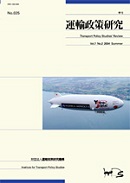Volume 7, Issue 2
Displaying 1-5 of 5 articles from this issue
- |<
- <
- 1
- >
- >|
Paper
-
2004 Volume 7 Issue 2 Pages 002-009
Published: July 30, 2004
Released on J-STAGE: May 31, 2019
Download PDF (898K) -
2004 Volume 7 Issue 2 Pages 010-019
Published: July 30, 2004
Released on J-STAGE: May 31, 2019
Download PDF (477K) -
2004 Volume 7 Issue 2 Pages 020-029
Published: July 30, 2004
Released on J-STAGE: May 31, 2019
Download PDF (508K)
Report
-
2004 Volume 7 Issue 2 Pages 030-036
Published: July 30, 2004
Released on J-STAGE: May 31, 2019
Download PDF (553K) -
2004 Volume 7 Issue 2 Pages 037-049
Published: July 30, 2004
Released on J-STAGE: May 31, 2019
Download PDF (622K)
- |<
- <
- 1
- >
- >|
